Menus
- V2, 1745 cm3, approx. 90 hp at 5500 rpm, 150 Nm at 3250 rpm, 355 kilos dry, from € 25,390
- The Dark Custom spirit touches the queen of the road
- Discovery
- In the saddle
- Engine and transmission
- In the city
- On motorways and main roads
- On departmental
- Part-cycle
- Brakes
- Comfort and duo
- Consumption & autonomy
- Conclusion
- Harley-Davidson Road King Special video test
V2, 1745 cm3, approx. 90 hp at 5500 rpm, 150 Nm at 3250 rpm, 355 kilos dry, from € 25,390
The Dark Custom spirit touches the queen of the road
Discreet and serious, this is how the Road King has always been since its appearance in the Harley-Davidson range in 1994. Integrated into the Touring range (as evidenced by its internal code name, which begins with FLH …), it offered its own definition of the art of carving the road, establishing a fairly unique cocktail of comfort and classicism. Indeed, the timeless lines had the merit of not going too far into the foil, while the level of comfort and equipment was just calibrated to go riding in good conditions (suitcases, a windshield, a saddle comfortable, what else?) without going overboard and glitzy reserved for the Electra Glide family.
Since the time it has been in the Harley catalog, the Road King has seen all the evolutions of the Big Twin with separate box: first born with a 1340 carbureted, it experienced the first increase in displacement to 1450 cm3, then the switch to injection, while the growth towards more displacement and more power was inevitable. Likewise, the Road King has also had a few variations, either in "Classic" (with white sidewall tires and leather cases), or in "Custom" (no windshield, more curved handlebars, leather saddlebags, again. more chrome …).

There, we change register: while benefiting from the mechanical and dynamic improvements which presided over the last generation of Harley-Davidson Touring with Milwaukee Eight 8-valve engines, the Road King also goes through the "Dark Custom" treatment, a both cooler, more relaxed, younger, more urban and also more "dark" vision of the thing.
The goal is obvious: to rejuvenate the Road King clientele.
Discovery
Frankly, it looks good, isn’t it? Let’s even say it looks like the first Road King you can buy before you get old. The absence of chrome parts, replaced by an engine and cycle parts completely treated in black, radically changes the perception we have of this machine. Well-dug two-seater saddle, high handlebars, rigid suitcases, omnipresent touches of black, up to the turn signal support through the central console, all this contributes to give it a sacred personality. Were it not for the front wheel and its "turbine" design, the large headlight nacelle, the faired fork and the crash bars almost give it the look of a 1940s military motorcycle..
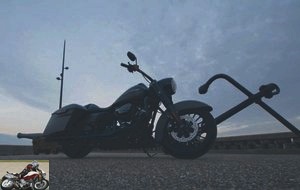
In the saddle
And yet, this machine is very modern. The suitcases are locked and the vehicle is started by a transponder. Once in the saddle (695 mm high, therefore accessible to the greatest world), we discover a simple counter but not stripped either. The big speedometer is on the tank (and to distinguish the lights or the digital window requires lowering your head). Cruise control is standard, while a button on the left stalk allows you to scroll through the information: two trips, clock, remaining range and the practical engine speed / gear combo.
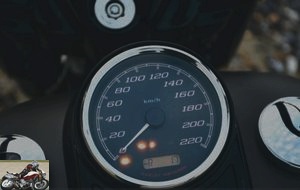
However, do not let the reasonable saddle height mislead you. The Road King Special remains a heavy and imposing motorcycle. With 355 kilograms dry and 1625 mm of wheelbase, it requires a little energy when maneuvering. And that’s not all: we’ll talk about it a little later.
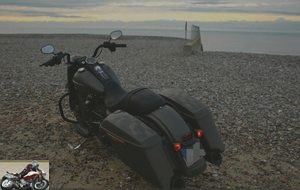
Harley-Davidsons have one thing in common with Honda. Yes, I know that from reading this sentence, we risk mass suicide in Milwaukee, but it is so. On a Honda, even since the late 1970s, when you ride it with your eyes closed, the precision of the controls, the feel of the clutch that has remained exactly the same for almost four decades, you know you are on a Honda. (you also know that you are on a Suzuki when the angle of the clutch lever is offset by 20 ° from that of the brake lever!). On a Harley, it’s the same: you think at first that the controls are firm, but in fact they are just consistent, precise, they give you that feeling of solidity and of a machine built with real metal..
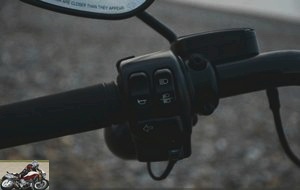
From a pressure on the starter, the big V2 comes to life and settles on an idle speed around 900 rpm. That’s it, we’re already in the mood.
Engine and transmission
With this new generation of machines, Harley-Davidson sometimes leaves the choice to the buyer to opt for the 107 (1750 cm3) or the 114 (1868 cm3) engine. This is not the case here: just like the other Road Kings, the Special is only available with the 107 and frankly, it’s already very good.
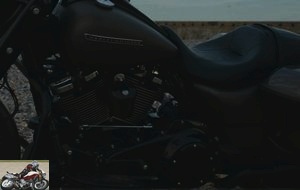
Because this engine, which we have already had the opportunity to test many times (and in particular on the Road King 107), does the job well here. Supple, round, vibrating a little but not too much, it seduces with its reach, its readiness to regain strength from low revs, its vigor when overtaking. In short, it is really fun to drive in all circumstances and fits perfectly with the philosophy of the machine. Euro 4 standards require, the sound is not too present, but its hum is pleasant enough to have fun while keeping the original pots. And in addition, it will avoid annoying the neighborhood.
Transmission side, it is a 6 box with double branch selector and final belt transmission.
In the city
Given its dazzling plastic, the Road King Special makes the city its natural habitat where it will only arouse admiration and wonder. Nevertheless, there are some good and some not so good.

The good thing is the balance of the chassis, the good self-stability at low speed, the flexibility of the engine which allows, by being really gentle on the gas, to cruiser at 1500 rpm in 4th at 50 km / h . The controls are soft (although the box "klonke" a bit), so everything is fine. Despite everything, the handlebars are wide (and at the level of the mirrors of the cars) and the mirrors of the Road King Special are at the level of those of the minivans..
On the other hand, you must be aware that the dimensions of the machine as well as the wide and high handlebars require you to have long enough arms to handle the maneuvers. Thus, despite its reasonable saddle height, it is not recommended for small riders who want to ride in the city. Finally, we will note the presence of warnings, which are activated on the upper part of the starter button..

On motorways and main roads
No problems on the mechanical side: the 107 has breath and is content to turn at a small 3000 rpm on the last report at 130 km / h, with still a nice reserve of power. However, that’s not to mention the driving position, which turns out not to be in sync with our highway paces. Obviously, it all depends on body shapes and consistencies, but in my case, I found that above 120 km / h (or even 110, in fact) the wind pressure started to get unpleasant. Two solutions: slow down or mount an optional windshield.

Otherwise, we’re good on the handlebars. Well wedged in the heavily hollowed saddle, well rocked by the pulsations of the big V-twin and the new chassis does not show any darting. On the other hand, the rear shock absorber is a little firm, in particular in relaxation. The 70-liter suitcases (in all) allow you to stick something to go on a weekend.
On departmental
At 90 km / h in the last gear, the big V2 turns at 2000 rpm and if you are on the immensity of Route 66 with the sun as the horizon, it must be a hell of a time. On the Normandy departmental roads in the vicinity of Treport, the setting for this test, on a cool and sticky winter day, it is, against all expectations, not bad either. !
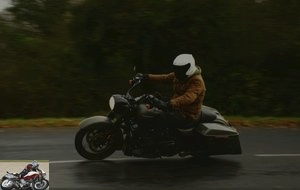
Quite simply because despite the weight, the machine remains surprisingly well balanced and can be carried along without any effort and without being overwhelmed by inertia, even on very rotten departmental roads. Apart from the dryness of the rear rebound damping, which has already been mentioned and given the type of vehicle, the machine has no particular faults and delivers a lot of pleasure. Of course, we are not going to talk about attack, but between the very correct braking, the ground clearance not so ridiculous as that (31 ° to the right and 32 ° to the left, is identical to that of a Fat Bob 114, that we had agreed to find rather dynamic during its test), the correct grip of the Michelin in the wet, everything is fine because the front axle is, dare we say the word, precise and that the rear follows without flinching. And let’s not forget that the V2 107 pulses downright well, to the point of saying that traction control would not be superfluous in certain conditions. We know that Harley is thinking about it for the next evolutions of its big cubes.
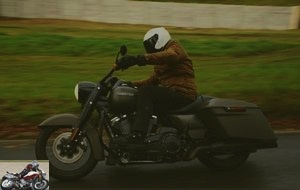
Part-cycle
It is very recent, the chassis, since it dates from 2016, when the latest generations of the Touring family arrived. Remember that the frame has been redesigned, that under the fairing, there is a new Showa valve fork and that the shock absorbers have been redesigned. One can suspect that for questions of look, the rear shocks are shorter and firmer than on the normal Road King, but Harley is not very good at the data sheets, no information circulates on this subject..

Brakes
Brembo which clamps 320mm discs front and rear: the device does the job and downright well, even. Obviously, given the geometry of the machine, we will tend to brake from the rear to first sit the machine, but both the power and the dosage are not lacking. In addition, the ABS does not tend to relax its effort at all costs..
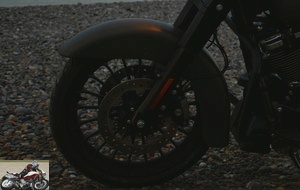
Comfort and duo
Here, the Road King Special is expected around the corner. First of all, because the man who designed a saddle that leans backwards certainly had torque problems and wanted to put his other half on the bike. As it stands, a sissy bar (optional) is the only solution to bring peace to the household. It should be noted with curiosity that the Road King standard and Classic have a flatter passenger seat..
Pilot side, all is well if we take the time to live. Without a windshield, the "mini ape hanger" handlebars make driving quickly painful above 120 km / h. Otherwise, it’s not bad.
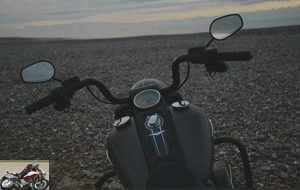
Consumption & autonomy
Note that the reserve indicator on the dashboard is quite precise: the remaining kilometers of autonomy are counted down and when we pass under the bar of "10 kilometers before running out of fuel", the indication "low range" appears. We can then put 21.6 l / 100 in a tank which contains 22.7. The fuel gauge, integrated in the false fuel cap on the left side, is also very precise. During this test, the consumption was regular, in a range going from 6 to 6.5 l / 100. In fact, we easily exceed the 350 kilometers of autonomy.
Conclusion
Harley-Davidsons who don’t hold the road, who don’t move forward and who don’t brake, all of this is definitely a thing of the past, as this Road King Special masterfully proves, but some cliches die hard. Still, it was a real pleasure to spend a good week of testing on the handlebars..
However, the pleasure does not obscure the realism. The Road King Special accepts two obvious facts: the first is that it is rudely beautiful. And the second is that you have to suffer to be beautiful. Because it is clear that despite its qualities and in this Special version, the Road King is no longer the queen of the road. Damping too firm in rebound, restrictive driving position at "high" speed, complicated duet because of the inclination of the saddle, the beautiful loses points.
At the same time, we have to put ourselves in the context: that of the States. A context where driving at 90/100 km / h cruising is one of the uses. A context where having a passenger super gaule of abs (because she is sheathing permanently to be able to stay in the back), is necessarily considered a super rewarding attribute to go show off on the beach in Malibu. In this case, the Road King Special is a very beautiful American, on the handlebars of which we will take pleasure in showing off on our old continent, knowingly….
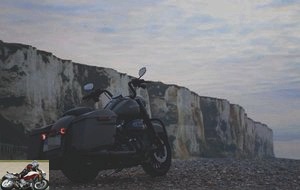
Strong points
- Very stylish look
- Really nice 107 engine
- Chassis balance
- Agility (yes, yes!)
- Driving pleasure in ride mode
- Quite powerful braking
Weak points
- Strenuous driving position at "high" speed
- Duo impossible without sissy-bar
- Firm rear shock
- Attractive price
- Barely readable counter
- Template not for the little ones…
The Harley-Davidson Road King Special technical sheet
Test conditions
- Itinerary: 800 km in a week of testing, with daily life in Paris and a trip to Normandy, at Le Treport
- Motorcycle mileage: 850 km
- Problem encountered: none, but given the state of the roads, it takes two days of cleaning before it regains its shine !
Competition: Indian Springfield Dark Horse
Harley-Davidson Road King Special video test
Related articles
-
Harley-Davidson Road King ‘107’ test
New 8-valve Milwaukee-Eight engine for this queen of the road 1745 cm3, approx. 90 horsepower, 150 N.m at 3250 rpm, 361 kilos dry, from 24,490 € Here, a…
-
Harley-Davidson Forty-Eight and A2 test
1202 cm3, approx. 60 horsepower at 5500 rpm, 96 Nm at 3500 rpm, 252 kilos with full tank, from 12,410 € A minimalist and very stylish machine, generous…
-
Harley-Davidson Ultra Limited Low ‘107’ test
New Milwaukee-Eight engine with 8 valves and mixed air / water cooling for this large road accessible to all 1745 cm3, approx. 90 hp, 152 N.m at 3250…
-
200 hp at 13,500 rpm, 112 N.m at 11,500 rpm, 199 kilos with full fuel, from € 18,499 Is the Crossplane engine an advantage in road use ? Even if the…
-
Harley-Davidson Sportster S Test
Haters gonna hate… VTwin Revolution Max 1250T, 1,252 cm3, 121 hp, 125 Nm, 228 kg in running order, from € 15,960 This is a machine that will appeal to…
-
Harley-Davidson CVO Road King test
Classic luxury bagger An essential bagger of the American brand, the Road King is available this year in a CVO (Custom Vehicle Operation) version,…
-
Harley-Davidson Road Glide Ultra test
1700 cm3, 80 hp, 138 Nm of torque, cruise control, GPS, audio, € 27,850 A test over almost 4,000 kilometers from Paris to Porto via Wheels Waves and…
-
Harley-Davidson CVO Limited ‘114’ test
New 8-valve Milwaukee-Eight engine for this absolute top of the line from Harley 1870 cm3, approx. 100 horsepower, 166 N.m at 3250 rpm, 414 kilos dry,…
-
Harley-Davidson Fat Bob 114 test
V2, 1868 cm3, 94 hp at 5020 rpm, 155 Nm at 3000 rpm, 306 kilos, from € 19,660 Change of style and philosophy for this machine that migrates from the Dyna…
-
Moto Guzzi V7 850 Special test
Heart transplantation and change of philosophy 853.4 cc 90 ° V-twin, 65 hp, 73 Nm The Guzzi V7 is a discreet monument of the motorcycle planet and…
"Very stylish look" … years 39-45 ??